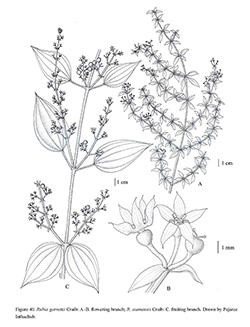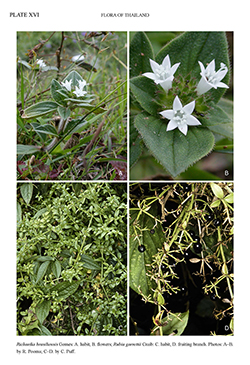e-Flora of Thailand
Volume 15 > Part 1 > Year 2021 > Page 231 > Rubiaceae > Rubia
2. Rubia garrettii Craibwfo-0000298484
Bull. Misc. Inform. Kew 1933: 29. 1933; Fl. Siam. 2: 232. 1934. Fig. 40A–B. Plate XVI: C–D.
Accepted Name : This is currently accepted.
Description : Straggling, scrambling, climbing or creeping perennial herbs to 4 m long; stems smooth. Leaves and leaf-like stipules in whorls of 4 (2 leaves of a whorl often conspicuously smaller than other 2), lanceolate to ovate-lanceolate, 0.6–1.5(–2) by 0.2–1(–1.5) cm, narrowed into conspicuous, but often only very short petiole (0.5–5 mm long), only midrib conspicuous. Inflorescence consisting of numerous several-flowered cymes in leaf axils. Flowers 5-merous. Corolla yellowish green; rotate (to very shallowly campanulate), 3–4 mm in diam. Ovary minute, < 1 mm across. Fruits consisting of 2 subglobose mericarps (1 sometimes aborted), shiny black and fleshy when fully mature; each mericarp 4–5 mm in diam.
Thailand : NORTHERN: Chiang Mai (Doi Inthanon, Angka – type: Garrett 325, holotype -K, isotypes -E L).
Distribution : Upper Myanmar.
Ecology : At the edge of upper montane rain forests, 2,450–2,550 m alt. Flowering: April–August; fruiting: July–January.
Vernacular : Phak si thit ton kliang (ผักสี่ทิศต้นเกลี้ยง), phak si thit bai hok (ผักสี่ทิศใบหอก).
Notes: For a long time thought to be a Doi Inthanon endemic, restricted to the summit area of the mountain.


